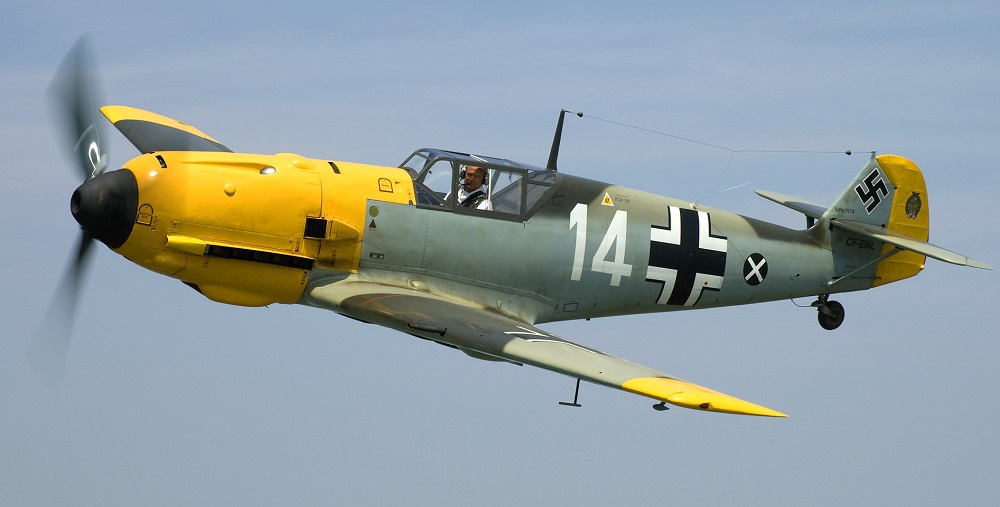
The Messerschmitt Bf 109, like the North American P-51,1 might have been the plane that never was. The Bayerische Flugzeugwerke (Bavarian Aircraft Company or BFW) was initially blocked from being sent contracts due to a long running feud between Willy Messerschmitt and the Secretary of State for Aviation, Erhard Milch.2 In order to save BFW from liquidation,3 Messerschmitt and his joint manager Herr Kokothanki, obtained a contract from a Romanian cartel, to develop the M-37 light transport. Protests were made against Messerschmitt's acceptance of a foreign contract, but Willy Messerschmitt argued that due to a lack of home support he was forced to seek contracts outside of Germany. Consequently, BFW was awarded a contract for fighter development.4
In 1934, the German Ministry of Aviation (Reichsluftfahrtministerium, or RLM) issued specifications for a new fighter
monoplane to replace the Heinkel He 51 and Arado 68 biplanes.5 It was to be equipped with at least two MG-17 7.9 millimeter machine guns, and to have the capability of utilizing the new 12-cylinder, liquid-cooled, vee-engines under development by Junkers and Daimler-Benz. The request was sent to Focke-Wulf, Arado, Heinkel and BFW. Focke-Wulf submitted the Fw 159V1, Arado the Ar 80V1 and Heinkel the He 112. The Bf 109 was the winner in the trials, exceeding its nearest rival, the Heinkel He 112, by 17 mph.6 Only the He 112 provided any other serious competition besides the Bf 109 in the trials and ten preproduction prototypes were ordered for the Heinkel He 112 and Bf 109.
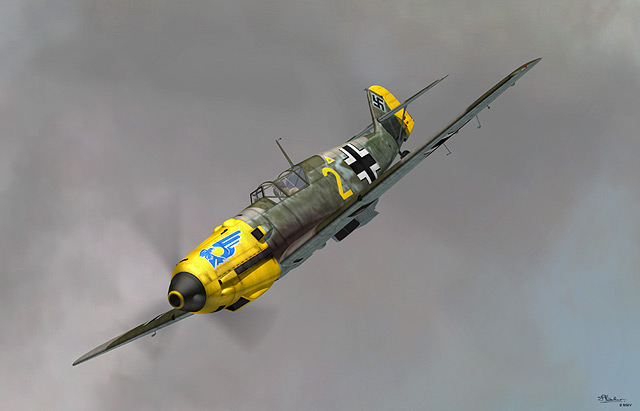
Messerschmitt Bf109E-1, belonging to 6./JG52, France 1940.
Despite the earlier odds of being issued a contract for a production fighter aircraft, Willy
Messerschmitt had been developing the Bf 109A alongside the Bf 108A.7
The first Bf 109 prototype, the Bf-109V1 had a British Rolls-Royce Kestrel engine when it made its debut in September 1935, and had a higher wing loading (24 lbs/sq ft.) than that of any other aircraft submitted for the competition. (The closet rival had 20.3 lbs/sq ft.)8 The "Bf-109V2" used a 455 kW (610 hp) Junkers Jumo 210A and was not fitted with armament. The Bf-109V3, was fitted with a pair of MG-17 7.9 mm machine guns. This armament arrangement was envisioned for the Bf 109A, but this production model was never flown, due to a new international requirement based on the view of the four-gun
Supermarine Spitfire and
Hawker Hurricane. Since no wing armament was required at the onset, the Bf 109 had a thin wing with the main spar at mid-chord, requiring a major wing redesign with later versions. On the opposing side, the Spitfire and Hurricane were designed with wing armament in mind from the very beginning. 9
Bearing in mind that the Bf 109 was to become one of the Royal Air Force's major opponents in the Second World War, it is ironic that the prototype had a 695 hp British Rolls-Royce Kestrel engine, when it made its debut in September 1935, as development of light weight aircraft military-type engines was prohibited under the Treaty Of Versailles. In any case, Rolls-Royce was using a German built Heinkel He 70 to flight test some of its latest engines at about the same time. 10
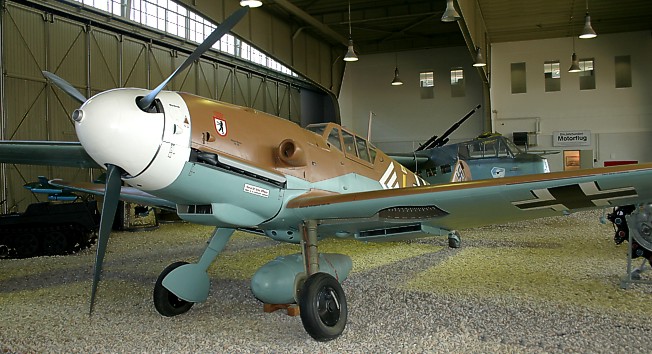
A Bf 109G-2 of the Air Force Museum in Gatow.
The Bf-109V4, first flown in November 1936, powered by a Jumo 210A engine was the first version to carry three machine guns in the nose. The third gun fired through the propeller spinner, but this gun was later replaced with a 20 mm, MG FF/M cannon. The Bf 109V5, Bf 109V6 and Bf 109V7 production prototypes flew early in 1937 powered by the Jumo 210B, paralleled the development of the Bf 109B. The Jumo 210B had the same power rating as the 210A for takeoff, but allowed greater power at high altitude and increased the service ceiling.
When first 'blooded' in the Spanish Civil War, it became clear to the German Condor Legion that their
Heinkel He 51 biplanes were inferior to Italian built fighters, and the Soviet Union
Polikarpov I-16s. Although not used in continuous service since they were prototypes, Bf-109V4, V5 and V6 were sent to Spain,11 and valuable front-line experience was gained to enhance further development. Meanwhile, Willy Messerschmitt was already preparing the first production Bf 109s for dispatch to Spain. The Bf 109B-1 was supplied to two Gruppen (groups), the JG 132, the "Richthofen" Jagdgeschwader (fighter wing) and the 2nd Staffel (squadron) of Jagdgruppe (fighter group) 88. Bf 109B-1s arrived in April 1937, and B-2s were supplied to the 1st Staffel of J/88 in August. The B-1 featured a 680 hp Jumo 210Da engine, a Reflexvisier gunsight, and a short-range FuG 7 radio.12 Approximately 30 B-1s were produced before they were replaced with B-2s. The main difference was the change from a fixed wooden prop to a VDM two blade variable-pitch prop.13 The 3rd Staffel was supplied with Bf 109Cs and Ds in April 1938. It wasn't long before the Republican forces found out their Polikarpov I-15s and
I-16s were no match for the Bf 109. A total of 136 Bf 109s had been sent to Spain, including the latest E model. Approximately 50 C-series, and 650 D-series were built.
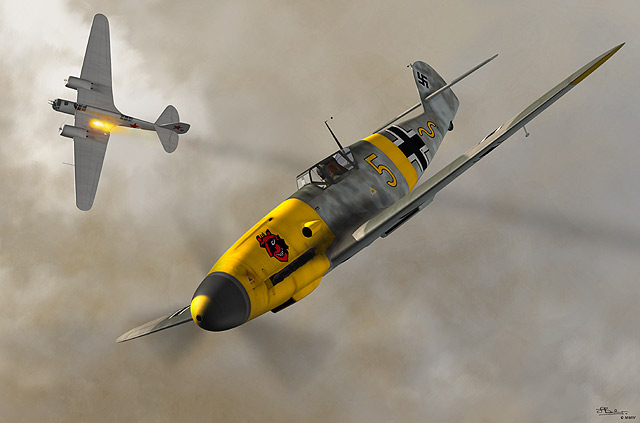
Messerschmitt Bf109F-2 belonging to 9./JG54, in combat with a Tupolev SB-2M100 Katyushka, Lithuania, July 1941.
The Bf 109E was the first true mass production model and was able to outfight or outrun virtually all opposition. Like the
Spitfire, the Bf 109 saw action throughout the war. This version was often referred to as the Me 109, but official German documentation referred to as the Bf 109, referring to the Bayerische Flugzeugwerke, although the company was reorganized as Messerschmitt A.G. in July, 1938.14
Bf 109V14 and V15, using the 1,050 hp (783 kW)
DB 601 engine, served as development aircraft for the Bf 109E. The additional heat generated by the DB 601 engine, required a major redesign, so additional radiators were installed in the wings, and an oil cooler was installed beneath the engine. Some E models were equipped with four MG 17s, and the remainder were equipped with two MG 17s in the fuselage and two MG FF cannons in the wing roots. Also produced was a bomber version, the Bf 109E-1/B, fitted with racks for four 50 kg (110 lb) or one 250 kg (550 lb) bombs. Additional equipment included a VDM three blade variable-pitch prop, Revi reflector gun sight, heavier armor for pilot protection,15 and a FuG 7 radio set. Like the Bf 109V7, fitted with a Jumo 210G fuel injected engine, the DB 601 installed on the E model was also fuel injected. This provided a greater advantage which maintained positive fuel flow during negative-g maneuvers, as opposed to float-carbureted type engines, which often sputtered or cut-out.16 The Bf 109E-3 had a provision for a 20-mm MG FF cannon firing through the prop spinner, however the cannon had proved unreliable, due to overheating, and was seldom used operationally.
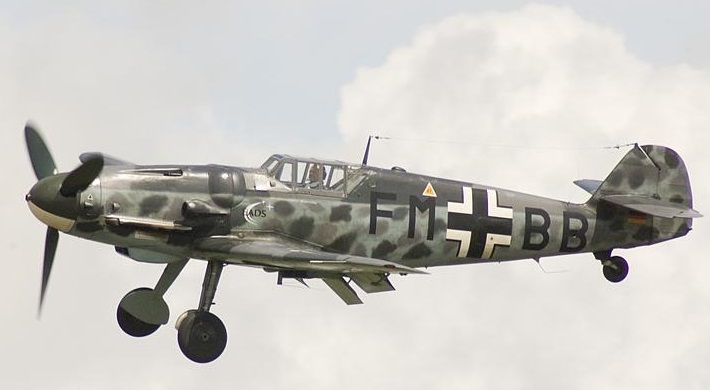
Characteristic of some Bf 109G versions were the bulges forward of the cockpit, covering the breeches of the engine mounted MG 131 machine guns. Above is a Bf 109G-6.
The Bf 109 had too limited a range to be fully effective as a bomber escort, so the German authorities found it to be most useful as a defensive fighter in Europe. This was reflected in the more refined, but relatively lightly-armed version of the fighter, the Bf 109F. Bf 109V21 and V24, using the 1,050 hp (783 kW) DB 601N engine, served as development aircraft for the Bf 109F. Gone were the wing root guns, prompting many pilot complaints. After Helmut Wick was killed on November 28, 1940, Major Walter Oesau refused to fly a Bf 109F as long as spare parts were available to keep his E-4 flying. Another German veteran who disliked the reduction in armament was Major Adolph Galland, who became a General at the age of thirty, and rose to be the Inspector-General of the Fighter arm.17 Slightly more than 2,000 Bf 109Fs were built before being replaced by the more heavily armed Bf 109G.18
Not until the arrival of the Bf 109G was faith in the type fully restored, and this version was built in huge numbers for a variety of roles. It was in a Bf 109G-14 that Major Erich Hartmann of the Luftwaffe reached his unrivaled total of 352 confirmed victories, although these were gained on the Eastern Front where German fighters easily outclassed the early Soviet fighters. From the summer of 1942 the Bf 109G powered by a Daimler-Benz DB 605D producing 1,800 hp with water-methanol injection and giving a speed of 685 km/h (428 mph), entered service in Russia and North Africa before being deployed in every other theater. With its standard armament of a cannon and two machine guns the Bf 109G, remained the major version right up to the end of hostilities in May 1945. The G model served with all forces Axis on the Eastern and Italian fronts, and was exported to Switzerland and Spain.
Approximately 35,000 Bf 109s of all versions were produced, (nearly as many as the Ilyushin Il-2 Shturmovik) but the true number can not be determined as parts from damaged airplanes of bombed-out factories were used to build other airplanes.19 Others were built in Czechoslovakia, and many went into Czech Air Force service after the war. Another post-war operator was Israel, and Bf 109s built by Hispano in Spain as HA-1109s and HA-1112s, were still active into the seventies. With the last of them, the wheel turned full circle. Like the original prototype, they were powered by a Rolls-Royce engine—this time the Merlin .
On April 26,1939,20 a specially prepared version, the Me 209 was fitted with greatly boosted engines, gained a series of world speed records, some of which were to remain unbeaten for 30 years. Its purpose was solely to break speed records and bore no resemblance to the Bf 109, other than the use of the Daimler Benz DB 601 engine. It flew to a new speed record of 470 mph (756 km/h) on April 26,1939. This record was not broken until August 16,1969, with a specially modified Grumman F8F Bearcat.21
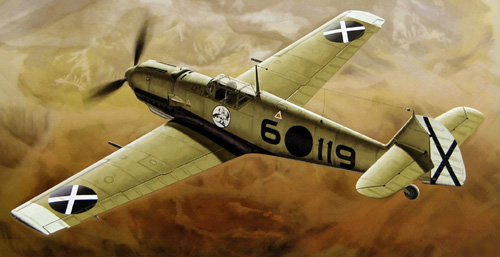
Messerschmitt Bf109E-3 of the Spanish Civil War.
|